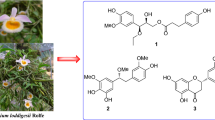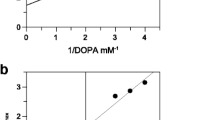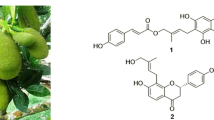Abstract
A novel vitamin E derivative, (6″-hydroxy-2″,5″,7″,8″-tetramethylchroman-2″-yl) methyl 3-(2′,4′-dihydroxyphenyl)propionate (TM4R), which has a chromanoxyl ring and 4-substituted resorcinol moieties, was synthesized; and its inhibitory effects on tyrosinase, antioxidant ability, and lightening effect of ultraviolet B (UVB)-induced hyperpigmentation were estimated. TM4R showed potent inhibitory activity on tyrosinase, which is the rate-limiting enzyme in melanogenesis. The scavenging activities of TM4R on 1,1-diphenyl-2-picrylhydrazyl and hydroxyl radicals were found to be nearly the same as those of α-tocopherol. Furthermore, an efficient lightening effect was observed following topical application of TM4R to UVB-stimulated hyperpigmented dorsal skin of brownish guinea pigs. These results suggest that TM4R may be a candidate for an efficient whitening agent, possibly by inhibiting tyrosinase activity and biological reactions caused by reactive oxygen species.
Similar content being viewed by others
Abbreviations
- COSY:
-
correlation spectroscopy
- DCC:
-
N,N′-dicyclohexyl-carbodiimide
- DMAP:
-
4-dimethylaminopyridine
- DMSO:
-
dimethylsulfoxide
- DOPA:
-
dihydroxyphenylalanine
- DPPacid:
-
3-(2′,4′-dihydroxyphenyl)propionic acid
- DPPH:
-
1,1-diphenyl-2-picrylhydrazyl
- ESR:
-
electron spin resonance
- HMBC:
-
heteronuclear multiple bond connectivity
- HR-FAB-MS:
-
high resolution-fast atom bombardment-mass spectrometry
- IC50 :
-
concentration at which 50% inhibition occurs
- NBA:
-
3-nitrobenzyl alcohol
- NMR:
-
nuclear magnetic resonance
- TM:
-
2-hydroxymethyl-2,5,7,8-tetramethylchroman-6-ol
- TM4R:
-
(6″-hydroxy-2″,5″,7″,8″-tetramethylchroman-2″-yl)methyl 3-(2′,4′-dihydroxyphenyl)propionate
- Trolox:
-
2-carboxy-2,5,7,8-tetramethylchroman-6-ol
- UV:
-
ultraviolet
- UVB:
-
ultraviolet B
References
Sánchez-Ferrer, A., Rodríguez-López, J.N., García-Gánovas, F., and García-Carmona, F. (1995) Tyrosinase: A Comprehensive Review of Its Mechanism, Biochim. Biophys. Acta 1247, 1–11.
Virador, V.M., Kobayashi, N., Matsunaga, J., and Hearing, V.J. (1999) A Standardized Protocol for Assessing Regulators of Pigmentation, Anal. Biochem. 270, 207–219.
Gilchrest, B.A., Park, H.Y., Eller, M.S., and Yaar, M. (1996) Mechanisms of Ultraviolet Light-Induced Pigmentation, Photochem. Photobiol. 63, 1–10.
Hayakawa, R. (1980) Clinical Research Group on a Combination Preparation of Vitamin E and C. Effects of Combination Preparation of Vitamin E and C in Comparison with Single Preparation to the Patients of Facial Hyperpigmentation: A Double-Blind Controlled Clinical Trial, Nishinihon J. Dermatol. 42, 1024–1034 (in Japanese).
Funasaka, Y., Chakraborty, A.K., Komoto, M., Ohashi, A., and Ichihashi, M. (1999) The Depigmenting Effect of α-Tocopheryl Ferulate on Human Melanoma Cells, Br. J. Dermatol. 141, 20–29.
Fukuzawa, K., and Gebicki, J.M. (1983) Oxidation of α-Tocopherol in Micelles and Liposomes by Hydroxy, Perhydroxy and Superoxide Free Radicals, Arch. Biochem. Biophys. 226, 242–251.
Burton, G.W., and Ingold, K.U. (1986) Vitamin E: Application of the Principles of Physical Organic Chemistry to the Exploration of Its Structure and Function. Acc. Chem. Res. 19, 194–201.
McEvily, A.J., Iyengar, R., and Gross, A.T. (1992) Inhibition of Polyphenol Oxidase by Phenolic Compounds, in Phenolic Compounds in Food and Their Effects on Health I. ACS Symposium Series, Vol. 506, pp. 318–325, Washington, DC.
Shimizu, K., Kondo, R., and Sakai, K. (2000) Imhibition of Tyrosinase by Flavonoids, Stilbenes and Related 4-Substituted Resorcinols: Structure-Activity Investigations, Planta Med. 66, 11–15.
Tasaka, K., Kamei, C., Nakano, S., Takeuchi, Y., and Yamato, M. (1998) Effects of Certain Resorcinol Derivatives on the Tyrosinase Activity and the Growth of Melanoma Cells, Meth. Find. Exp. Clin. Pharmacol. 20, 99–109.
Jiménz, M., and García-Carmona, F. (1997) 4-Substituted Resorcinols (sulfite alternatives) as Slow-Binding Inhibitors of Tyrosinase Catecholase Activity, J. Agric. Food Chem. 45, 2061–2065.
Murase, H., Yamauchi, R., Kato, K., Kunieda, T., and Terao, J. (1997) Synthesis of a Novel Vitamin E Derivative, 2-(α-D-Glucopyranosyl) methyl-2,5,7,8-tetramethylchroman-6-ol, by α-Glucosidase-Catalyzed Transglycosylation, Lipids 32, 73–78.
Shimizu, K., Kondo, R., Sakai, K., Lee, S.H., and Sato, H. (1998) The Inhibitory Components from Artocarpus incisus on Melanin Biosynthesis, Planta Med. 64, 408–412.
Arroyo, C.M., Wade, J.V., Ichimori, K., and Nakazawa, H. (1994) The Scavenging of Hydroxyl Radical (·OH) by a Prostacyclin Analogue, Taprostene, Chem.-Biol. Interact. 91, 29–38.
Yokota, T., Nishio, H., Kubota, Y., and Mizoguchi, M. (1998) The Inhibitory Effect of Glabridin from Licorice Extracts on Melanogenesis and Inflammation, Pigment. Cell. Res. 11, 355–361.
Mishima, Y., Ohyama, Y., Shibata, T., Seto, H., and Hatae, S. (1994) Inhibitory Action of Kojic Acid on Melanogenesis and Its Therapeutic Effect for Various Human Hyper-Pigmentation Disorders (in Japanese), Hifu (Skin Res.) 36, 134–150.
Sugai, T. (1992) Clinical Effects of Arbutin in Patients with Chloasma (in Japanese), Hifu (Skin Res.) 34, 522–529.
Cabanes, J., Chazarra, S., and Garcia-Carmona, F. (1994) Kojic Acid, a Cosmetic Skin Whitening Agent, Is a Slow-Binding Inhibitor of Catecholase Activity of Tyrosinase, J. Pharm. Pharmacol. 46, 982–985.
Maeda, K., and Fukuda, M. (1996) Arbutin: Mechanism of Its Depigmenting Action in Human Melanocyte Culture, J. Pharmacol. Exp. Ther. 276, 765–769.
Imokawa, G., Kawai, M., Mishima, Y., and Motegi, I. (1986) Differential Analysis of Experimental Hypermelanosis Induced by UVB, PUVA, and Allergic Contact Dermatitis Using a Brownish Guinea Pig Model, Arch. Dermatol. Res. 278, 352–362.
Kubo, I., and Hinst-Hori, I. (1998) Tyrosinase Inhibitors from Cumin, J. Agric. Food Chem. 46, 5338–5341.
van Gelder, C.W.G., Flurkey, W.H., and Wichers, H.J. (1997) Sequence and Structural Features of Plant and Fungal Tyrosinase, Phytochemistry 45, 1309–1323.
Jimenez-Cervantes, C., Garcia-Borron, J.C., Valverde, P., Solano, F., and Lozano, J.A. (1993) Tyrosinase Isoenzymes in Mammalian Melanocytes. 1. Biochemical Characterization of 2 Melanosomal Tyrosinase from B16 Mouse Melanoma, Eur. J. Biochem. 217, 549–556.
Hruza, L.L., and Pentland, A.P. (1993) Mechanisms of UV-Induced Inflammation, J. Invest. Dermatol. 100, 35s-41s.
Kobayashi, N., Muramatsu, T., Yamashina, Y., Shirai, T., Ohnishi, T., and Mori, T. (1993) Melanin Reduces Ultraviolet-Induced DNA Damage Formation and Killing Rate in Cultured Human Melanoma Cells, J. Invest. Dermatol. 101, 685–689.
Bissett, D.L., Chatterjee, R., and Hannon, D.P. (1990) Photoprotective Effect of Superoxide-Scavenging Antioxidants Against Ultraviolet Radiation-Induced Skin Damage in the Hairless Mouse, Photodermatol. Photoimmunol. Photomed. 7, 56–62.
Jurkiewicz, B.A., Bissett, D.L., and Buettner, G.R. (1995) Effect of Topically Applied Tocopherol on Ultraviolet Radiation-Mediated Free Radical Damage in Skin, J. Invest. Dermatol. 104, 484–488.
Clement-Lacroix, P., Michel, L., Moysan, A., Morliere, P., and Dubertret, L. (1996) UVA-Induced Immune Suppression in Human Skin: Protective Effect of Vitamin E in Human Epidermal Cells in vitro, Br. J. Dermatol. 134, 77–84.
Werninghaus, K., Handjani, R.-M., and Gilchrest, B.A. (1991) Protective Effect of α-Tocopherol in Carrier Liposomes on Ultraviolet-Mediated Human Epidermal Cell Damage in vitro, Photodermatol. Photoimmunol. Photomed. 8, 236–242.
Kubo, I., Kinst-Hori, I., Kubo, Y., Yamagiwa, Y., Komikawa, T., and Haraguchi, H. (2000) Molecular Design of Antibrowning Agents, J. Agric. Food Chem. 48, 1393–1399.
Author information
Authors and Affiliations
Corresponding author
About this article
Cite this article
Shimizu, K., Kondo, R., Sakai, K. et al. Novel vitamin E derivative with 4-substituted resorcinol moiety has both antioxidant and tyrosinase inhibitory properties. Lipids 36, 1321–1326 (2001). https://doi.org/10.1007/s11745-001-0847-9
Received:
Revised:
Accepted:
Issue Date:
DOI: https://doi.org/10.1007/s11745-001-0847-9




